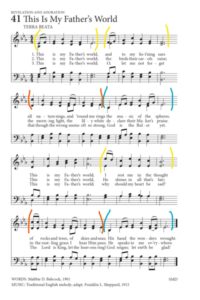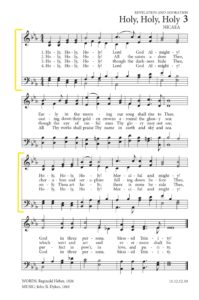Congregational Singing
CONGREGATIONAL SINGING
Vibrant congregational singing is an important element of corporate worship.
Below, you will find guidance for choosing congregational songs
that are theologically rich and singable.
What will help congregations sing?
It is important to choose songs that will encourage the congregation to sing. Read below for instruction concerning factors you should consider when selecting congregational songs.
A typical formula for good congregational songs is simple + engaging.
However, as a song gets “simpler” melodically and harmonically, it becomes boring. The only way to make it “engaging” is with factors that actually discourage congregational singing like complex rhythm, loud dynamics, and professional performance.
A better formula for good congregational songs is singable + rich.
“We must remember first that singing is not just as affair of the voice. It is just as much, if not more, an affair of the mind. A good voice and plenty of breath are fine things to have; but if you cannot imagine in your mind’s ear the pitch of the next note in a tune you cannot sing it. And in matters of rhythm, if you cannot visualize the length of a note you will not know when to stop singing it, which may be just as awkward.”
—John Wilson, “Looking at Hymn-Tunes: The Objective Factors,” p. 24.
Consideration for what makes a song singable for an average worshiper will give careful consideration to the following factors:
- Melodic Outline
- Rhythm
- Harmony
- Overall Structure
Use the guide on the right to walk you through each of these factors.
- Lyrics with profound theology.
- Lyrics with poetic depth.
- Interesting melody that uses both steps and leaps.
- Interesting harmony that supports the melody.
Planning Congregational Songs
Once you have chosen songs that are singable and rich, plan them in your service in a logical, gospel-shaped progression. Click here for more details on gospel-shaped service planning.
Introducing New Songs
Introduce new songs carefully. Here are some methods for introducing new songs:
- Recordings
- Informal meetings
- Use groups/soloists
- Antiphonal/responsorial singing
- Emails
- Song of the month
- Repetition early, then into the rotation
- Hymnals / bulletin inserts
- Hymn services, festivals, hymn sings
- 120 songs max
- Quarterly rotation
- As new songs are introduced, songs of lesser value are trimmed
- Hymnal
- Formal teaching of your team
- Formal teaching of the congregation
- Careful placement within the liturgy
- Carefully planned introduction of songs/liturgy
Musical Evaluation
Use the guide below to learn factors that contribute to songs that are singable and rich.
According to John Wilson (“Looking at Hymn-Tunes: The Objective Factors”), successful tunes will have the following attributes:
- The melody will have a judicious mixture of leaps and steps.
- The melody will maintain its poise as it moves, balancing rise and fall without spending too long on the heights or in the depths.
- The melody will respect congregational limits in matters of pitch and vocal climax.
A successful song will have fairly straightforward rhythms in the melody. Rhythm that is too complicated will make it very difficult for a congregation to sing. Instead, choose songs with simple rhythm but interesting melody and harmony and enriching lyrics.
When singing a congregational song, choose a key that makes the melody line accessible to the congregation, not necessarily what is most comfortable for the music leader or praise team. The song key should be determined by the melodic range. Strive to keep the melody line within the voice range overlap of all voice types. Based on the vocal ranges given in the New Harvard Dictionary of Music voice categories, a strict voice range overlap, based on octave equivalence, is C4-C5. A more flexible voice range overlap would increase each limit by a tone to Bb3-D5.
“The pitch of the highest acceptable note depends on so many factors, both psychological and vocal, that generalization is difficult. For unison singing in a mixed congregation, a top E is only just acceptable if all the conditions are good. What is important to singers, if they are to make the extra effort, is the appropriate placing of the high note and the way it is approached.”
—John Wilson, “Looking at Hymn-Tunes: The Objective Factors,” p. 129.
Good songs will have interesting harmony that supports the melody.
Leading Congregational Songs
How songs are led contributes to how well the congregation will sing them. Use the guide below to learn important considerations for leading congregational songs.
High decibel playing may increase the perceived “energy” of a song, but it discourages congregational singing. If the congregation cannot hear themselves and others sing, they will not sing. Our goal is not for the congregation to “sing along” with a band, but to sing!
Accompany the singing with a volume that supports the singing but does not overpower it.
Pace the song so that it both accurately reflects the message of the text and encourages singing. Sing slow enough so people have time to breath, but not so slow that they have to breath every other word.
When leading a congregational song, make sure the melody is audible to the congregation and that the melodic line is sung without improvisation. Church members learning a new song rely on the song leader to present a clear melody from which they can follow. Without a clear melodic line provided, church members will struggle to learn the melody, much less sing it with confidence.
Often music leaders do not have control over the acoustics of the room in which the worship takes place. However, if you do, design the space so that it acoustically supports live singing, not recording (which is often intentionally dead).
Turn up the lights! A concert mentality has led many churches to darken the congregation while intensely lighting the “stage.” This discourages congregational singing and gives the impression that the performers on the stage are the only singers who are important. Light up the entire congregation so that they can see each other.

 Subscribe to our channel
Subscribe to our channel
